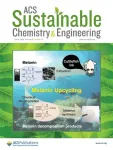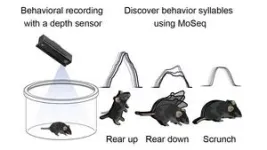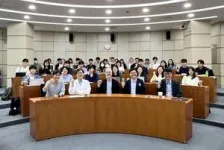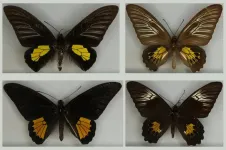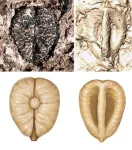(Press-News.org) Every year, the negative effects of human activities on the environment become increasingly clear. From climate change and microplastics to the endangerment and extinction of countless species, it is evident that we need to find new ways to achieve sustainability. Fortunately, many research groups in prominent fields like chemistry and materials science are tirelessly working to develop solutions to get us closer to circular and sustainable economies.
One area that has attracted much attention in this regard is biomass upcycling. It refers to the transformation of naturally available organic materials into valuable products, such as biofuels and bioplastics. While many scientific studies have focused on plant-derived biomass, such as cellulose fibers, the potential of melanin as a biomass resource remains understudied. One of the main reasons for this is that the decomposition of melanin—a complex yet ubiquitous biopolymer—needs to be further explored.
In a recent study published in ACS Sustainable Chemistry & Engineering, a research team led by Associate Professor Michinari Kohri from the Graduate School of Engineering at Chiba University, Japan, set out to address this knowledge gap. Using both artificially and naturally sourced melanin, they performed a detailed analysis of the decomposition of melanin and showcased its upcycling potential. Their paper, which was made available online on April 19, 2024, and published in Volume 12, Issue 18 of the journal on May 6, 2024, was co-authored by Mr. Takumi Morita and Prof. Keiki Kishikawa from the Graduate School of Engineering at Chiba University, Prof. Toshihiko Matsuura from the Laboratory of Biotechnology and Bioengineering at Hokkaido University of Education, and Prof. Hironori Izawa from the Faculty of Engineering at University of Miyazaki.
First, the researchers synthesized artificial melanin from polydopamine, obtaining a polymer that is structurally very similar to natural melanin. Using powdered samples as a model substance, they ran a series of decomposition tests under various conditions, followed by a series of analytical experiments on the resulting decomposition products.
Afterward, they repeated many of these tests on natural melanin, which they extracted from the ink sacs of cuttlefish. “From a resource perspective, the melanin concentrated in the ink sacs of cuttlefish and squid is easily recoverable natural melanin. The catch of squid and octopus has been increasing yearly and hovering around three million tons for the past few years,” explains Dr. Kohri. Interestingly, the researchers found that both artificial and natural melanin were decomposed into pyrrole derivatives containing carboxylic acids. This result suggests that melanin derived from other renewable and easily accessible sources, such as insect exoskeletons, animal hair, or melanin-producing microorganisms, could be equally useful as a chemical precursor.
Finally, using the decomposition products obtained from artificial and natural melanin as raw materials, the researchers prepared various polymer films and particles. These experiments serve as a demonstration of the untapped potential of melanin in biomass upcycling. “Since melanin is naturally abundant biomass and eventually gets degraded by microorganisms, polymeric materials produced using melanin decomposition products are probably also biodegradable,” highlights Dr. Kohri. “Biodegradable polymers can be disposed of without harming the environment, and thus, the proposed approach for making polymers from melanin decomposition products could lead to the development of sustainable materials.”
Overall, the findings of this study could pave the way to the widespread adoption of melanin upcycling, which could ultimately help us protect the environment. “Just as research on cellulose biomass has advanced because cellulose can be extracted from a variety of underutilized plants, we hope our efforts bolster the use of melanin as a biomass resource,” concludes Dr. Kohri, with eyes on the future.
We echo the team’s wishes for more environmentally friendly practices and look forward to what’s on the horizon for melanin upcycling.
About Associate Professor Michinari Kohri
Michinari Kohri obtained a PhD in Engineering from Tohoku University in 2007. He currently holds the title of Associate Professor at the Department of Applied Chemistry and Biotechnology, Graduate School of Engineering, Chiba University. His research is centered around polymer chemistry, colloid chemistry, and functional materials, with a particular focus on structural colors, biomass upcycling, and soft magnetic materials. He has published over a hundred papers on these topics and is a member of various scientific societies, including The Chemical Society of Japan, The Society of Polymer Science (Japan), and The Japanese Liquid Crystal Society.
END
Melanin from cuttlefish ink as a sustainable biomass resource
Researchers investigate the potential of naturally sourced melanin in the sustainable synthesis of biopolymers
2024-07-01
ELSE PRESS RELEASES FROM THIS DATE:
AI-powered study explores under-studied female evolution
2024-07-01
Pioneering AI-powered research on butterflies has probed the under-studied evolution of females and adds to a debate between the founding fathers of evolution.
The University of Essex study – published in Communications Biology – explores a controversy between Victorian scientists Charles Darwin and Alfred Russel Wallace.
Darwin thought males had more variation, as females often chose mates based on male appearance.
Whereas Wallace thought natural selection across sexes was the biggest factor in difference.
For over a century, scientists ...
New findings may fix the replicability crisis in microbiome research
2024-07-01
Our bodies are inhabited by trillions of microorganisms, with specific microbes unique to each individual. Through experimentation, scientists have pinpointed certain factors that account for variation in the gut: diet, living conditions, exercise and maternal line. Now, scientists at University of California San Diego have discovered another factor that affects the composition of the gut microbiome: time of day. In fact, the scientists have found that time of day is such an important factor that they’re calling on the National Institutes of Health (NIH) to require researchers ...
Nanorobot with hidden weapon kills cancer cells
2024-07-01
Researchers at Karolinska Institutet in Sweden have developed nanorobots that kill cancer cells in mice. The robot’s weapon is hidden in a nanostructure and is exposed only in the tumour microenvironment, sparing healthy cells. The study is published in the journal Nature Nanotechnology.
The research group at Karolinska Institutet has previously developed structures that can organise so-called death receptors on the surface of cells, leading to cell death. The structures exhibit six peptides (amino acid chains) assembled in a hexagonal pattern.
“This hexagonal nanopattern of peptides becomes a lethal weapon,” explains Professor ...
Largest ever genetic study of age of puberty in girls shows links with weight gain
2024-07-01
Genes can indirectly influence the age at which girls have their first period by accelerating weight gain in childhood, a known risk factor for early puberty, a Cambridge-led study has found. Other genes can directly affect age of puberty, some with profound effects.
In the largest study of its kind to date, an international team led by researchers at the Medical Research Council (MRC) Epidemiology Unit, University of Cambridge, studied the DNA of around 800,000 women from Europe, North America, China, Japan, and Korea.
Published today in Nature Genetics, the researchers found more than 1,000 variants – small changes in DNA – that ...
Sixty-million-year-old grape seeds reveal how the death of the dinosaurs may have paved the way for grapes to spread
2024-07-01
If you’ve ever snacked on raisins or enjoyed a glass of wine, you may, in part, have the extinction of the dinosaurs to thank for it. In a discovery described in the journal Nature Plants, researchers found fossil grape seeds that range from 60 to 19 million years old in Colombia, Panama, and Peru. One of these species represents the earliest known example of plants from the grape family in the Western Hemisphere. These fossil seeds help show how the grape family spread in the years following the death of the dinosaurs.
“These are the oldest grapes ever found in this part of the world, and they’re a few million years ...
AI model finds the cancer clues at lightning speed
2024-07-01
Researchers at the University of Gothenburg have developed an AI model that increases the potential for detecting cancer through sugar analyses. The AI model is faster and better at finding abnormalities than the current semi-manual method.
Glycans, or structures of sugar molecules in our cells, can be measured by mass spectrometry. One important use is that the structures can indicate different forms of cancer in the cells.
However, the data from the mass spectrometer measurement must be carefully analysed by humans to work out the structure from the glycan fragmentation. This process can take anywhere from hours ...
Individuals can tell if their memories are trustworthy, new study shows
2024-07-01
How much trust should we put in our memories? New research shows we have a good awareness of when we are recalling events accurately – and when our brain is filling in gaps with general knowledge.
Memories are a blend of recalled details and ‘prototypical’ information, but a study at the University of Birmingham has shown that when prototypes appear more prominent, we become less confident in the recollection.
This means that we are able to distinguish between these two types of memory, and accurately assess how ...
Palliative care beneficial to manage symptoms, improve quality of life for people with CVD
2024-07-01
Statement Highlights:
Palliative medication management focuses on providing relief from symptoms and enhancing quality of life for people with cardiovascular disease throughout the various stages of the disease.
Decisions about initiating, adjusting or discontinuing cardiovascular and other medicines should be patient-centered and include input from multiple specialties including cardiology experts in close collaboration with primary care professionals.
Evidence shows that adding palliative care interventions to standard cardiovascular ...
How researchers are using digital city-building games to shape the future
2024-07-01
Lancaster University researchers have come up with exciting and sophisticated new mapping technology enabling future generations to get involved in creating their own future built landscape.
They say, in their new research published today, that planners are missing a real trick when it comes to encouraging and involving the public to help shape their own towns, cities and counties for the future.
They also say that games platforms can be used to plan future cities and also help the public immerse themselves in these future worlds.
The researchers have modified Colossal Order’s game ‘Cities: Skylines’ ...
New professorship for Large Engines Research at Graz University of Technology
2024-07-01
Large engines are essential for the global transport and energy sector, powering container ships, locomotives, decentralised power plants and heavy construction machinery. In many areas, battery-powered electric engines are not feasible, which is why the further development of large combustion engines is a key factor for meeting climate protection targets: through greater efficiency, but above all by using new, climate-neutral fuels. In order to strengthen research and the training of specialists in this field, Graz University of Technology ...
LAST 30 PRESS RELEASES:
Injectable breast ‘implant’ offers alternative to traditional surgeries
Neuroscientists devise formulas to measure multilingualism
New prostate cancer trial seeks to reduce toxicity without sacrificing efficacy
Geometry shapes life
A CRISPR screen reveals many previously unrecognized genes required for brain development and a new neurodevelopmental disorder
Hot flush treatment has anti-breast cancer activity, study finds
Securing AI systems against growing cybersecurity threats
Longest observation of an active solar region
Why nail-biting, procrastination and other self-sabotaging behaviors are rooted in survival instincts
Regional variations in mechanical properties of porcine leptomeninges
Artificial empathy in therapy and healthcare: advancements in interpersonal interaction technologies
Why some brains switch gears more efficiently than others
UVA’s Jundong Li wins ICDM’S 2025 Tao Li Award for data mining, machine learning
UVA’s low-power, high-performance computer power player Mircea Stan earns National Academy of Inventors fellowship
Not playing by the rules: USU researcher explores filamentous algae dynamics in rivers
Do our body clocks influence our risk of dementia?
Anthropologists offer new evidence of bipedalism in long-debated fossil discovery
Safer receipt paper from wood
Dosage-sensitive genes suggest no whole-genome duplications in ancestral angiosperm
First ancient human herpesvirus genomes document their deep history with humans
Why Some Bacteria Survive Antibiotics and How to Stop Them - New study reveals that bacteria can survive antibiotic treatment through two fundamentally different “shutdown modes”
UCLA study links scar healing to dangerous placenta condition
CHANGE-seq-BE finds off-target changes in the genome from base editors
The Journal of Nuclear Medicine Ahead-of-Print Tip Sheet: January 2, 2026
Delayed or absent first dose of measles, mumps, and rubella vaccination
Trends in US preterm birth rates by household income and race and ethnicity
Study identifies potential biomarker linked to progression and brain inflammation in multiple sclerosis
Many mothers in Norway do not show up for postnatal check-ups
Researchers want to find out why quick clay is so unstable
Superradiant spins show teamwork at the quantum scale
[Press-News.org] Melanin from cuttlefish ink as a sustainable biomass resourceResearchers investigate the potential of naturally sourced melanin in the sustainable synthesis of biopolymers
